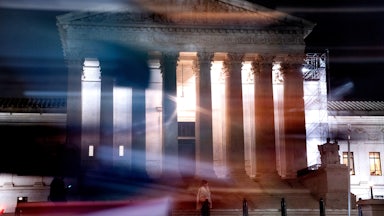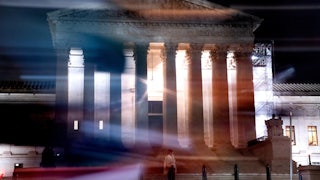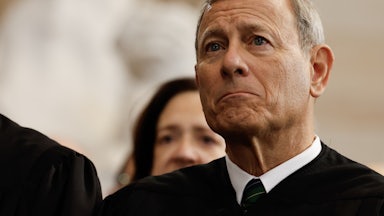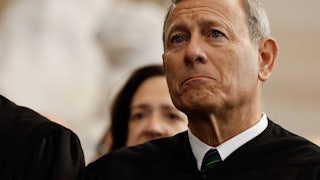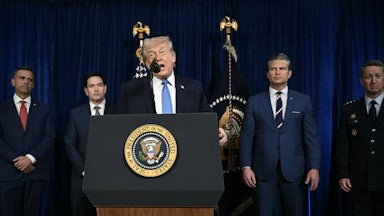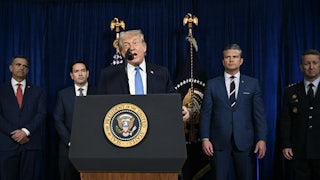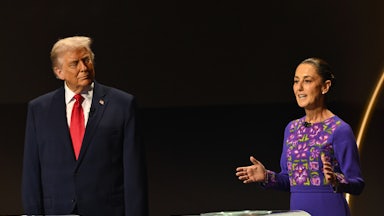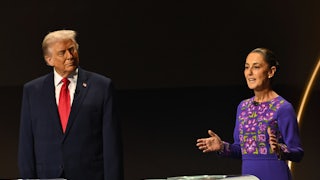A top Trump-aligned legal group filed a lawsuit last week that argued that two key components of the judicial branch are actually part of the executive branch—a novel legal theory that would radically expand President Donald Trump’s influence over the federal courts.
The America First Legal Foundation, or AFLF, was founded by top Trump adviser Stephen Miller and enjoys close ties with the administration. It argued in its complaint last week that the agencies at issue—the Judicial Conference of the United States and the Administrative Office of the U.S. Courts—exercise regulatory power and not judicial power, despite the fact that their work is closely tied to the functioning of the federal courts.
Under the Supreme Court’s most recent separation-of-powers decisions, AFLF claimed, the two agencies must therefore fall within the executive branch’s power. “[Both agencies] must be overseen by the president, not the courts,” the group asserted. “Judicial relief here not only preserves the separation of powers but also keeps the courts out of politics.”
The lawsuit does not technically come from Trump or his administration. Nonetheless, it amounts to a serious threat to judicial independence that is being carried out on the president’s behalf. If successful, it would wrest control of the federal courts’ support agencies away from Chief Justice John Roberts and place them in Trump’s hands instead, with dire implications for the rule of law.
AFLF v. Roberts is ostensibly about an entirely different matter: the Freedom of Information Act. The post-Watergate transparency law allows private citizens to obtain copies of certain government records from various federal agencies upon request. Congress placed limits on the kinds of records that can be obtained through FOIA, as well as limits on the government agencies and institutions from which they can be obtained.
Congress itself—including its committees and the individual offices of its representatives and senators—is not subject to FOIA requests, for example. Nor are the Supreme Court and the lower federal courts. The Smithsonian Institution is not considered to be an “agency” within FOIA’s terms. The Executive Office of the President and its components, which are usually just referred to as “the White House,” are also exempt.
Among those government bodies that are traditionally not subject to FOIA are the two at question here. The Judicial Conference is the chief policymaking body for the federal courts, headed by the chief justice of the United States and various other federal judges from around the country. It periodically revises the various federal rules of court procedure, supervises the courts’ electronic docket systems, and investigates federal judges for wrongdoing and potential impeachment.
The Administrative Office is the federal judiciary’s administrative arm. In addition to providing support staff for the Judicial Conference itself, it provides a “broad range of legislative, legal, financial, technology, management, administrative, and program support services” to the federal courts as a whole, according to its own website. In essence, the Administrative Office does everything for the courts but decide cases and write rulings. Its director is appointed by the chief justice, and its work is overseen by the Judicial Conference as a whole.
Both agencies are the product of an early twentieth-century push to bolster the federal judiciary’s independence. Congress established the Judicial Conference in 1922 at the behest of former president and then–Chief Justice William Howard Taft to give the federal courts more control over their own inner workings. In 1939, Congress created the Administrative Office to place under the judiciary’s control certain administrative powers that were previously carried out by the Justice Department.
This state of affairs went unquestioned by lawmakers, presidents, judges, and the general public for the last nine decades until AFLF sent a FOIA request to Roberts himself last summer. The request doubled as a broad attack on the Judicial Conference and the Administrative Office and Roberts’s own power over them. AFLF said it sought any records held by the two agencies that involved Rhode Island Senator Sheldon Whitehouse and his criticism of alleged ethical lapses by Justices Clarence Thomas and Samuel Alito.
The two conservative justices have come under public and congressional scrutiny in recent years for trips and vacations provided by conservative billionaires that weren’t reported in their annual ethics disclosures. In response, the Judicial Conference promulgated new regulations that narrowed the definition of what counted as “personal hospitality,” a category of gifts that is not required to be reported, to clarify matters in the future. AFLF framed this saga in its complaint last week as “an onslaught to destroy the impartiality and political neutrality of Article III courts and, particularly, the Supreme Court” by “the media and enterprising lawmakers.”
“This lawfare has been led by Senator Sheldon Whitehouse and Representative Hank Johnson, relying upon an ideologically favorable legacy media, to falsely accuse Justices Thomas and Alito of ethical improprieties,” the group complained. “Their aim was simple: to chill the judicial independence of these Supreme Court justices.”
AFLF had good reason to think that Roberts would ignore its FOIA request. Federal courts have previously ruled that the Judicial Conference and the Administrative Office were exempt from FOIA. In a 2008 decision, for example, Judge Emmet Sullivan held that the two agencies fell under the law’s exemption for the “courts of the United States” because that term referred to the entire judicial branch, not merely the individual courts themselves.
In anticipation of Roberts’s refusal, AFLF laid out an argument for why the two agencies were actually part of the executive branch. The group took an exceptionally narrow view of what counted as the “judicial branch,” arguing that only the courts themselves fell within it. “Courts have the power to interpret and apply the law to resolve disputes between adversaries,” the group argued. “They do not create law, which is the responsibility of Congress, nor do they enforce it, which is the responsibility of the President.”
The Judicial Conference, though led by judges, is not a court of law. Since it exercises regulatory powers over the courts and oversees the Administrative Office, AFLF argued that it is more akin to an executive branch agency. It also not-so-subtly suggested that Roberts’s power to appoint and dismiss the Administrative Office’s director was unconstitutional, by saying that it was subject to “potential constitutional constraints.”
Ironically, this monster is one of Roberts’s own making. The chief justice and his conservative allies have chipped away at constitutional protections for independent federal agencies in recent years, holding that the president must be able to hire and fire the heads of the Consumer Financial Protection Bureau, in 2020, and the Federal Housing Finance Agency, in 2021, whenever he wishes. The justices have sharply narrowed a 1935 Supreme Court case that insulated certain agencies from the executive branch’s whims and, if Trump has his way, may overturn it altogether in the next few years.
Nonetheless, the Administrative Office responded last November that FOIA does not apply to the judiciary and cited the available case law that supported that conclusion. (It also insisted that most of what AFLF sought would be covered by various other exceptions, either way, but that part isn’t really relevant here.) AFLF responded by filing this lawsuit, which used the denied FOIA request to argue that the federal judiciary’s policymaking and administrative bodies actually belong to the president.
The group argued—directly, this time—that Roberts’s ability to hire and fire the Administrative Office’s director was unconstitutional, citing a 2021 Supreme Court ruling written by Roberts that reaffirmed that only presidents may appoint federal officials who carry out significant executive branch duties. “The Judicial Conference’s duties are executive functions and must be supervised by executive officers who are appointed and accountable to other executive officers,” the lawsuit claimed.
All of this is ridiculous under any reasonable understanding of the separation of powers. Judicial independence requires keeping certain functions within the judiciary’s control. The so-called “Department of Government Efficiency” is a bracing lesson for what an aggressive and adversarial president could try to do if he had control of these two agencies. Trump could stack the Judicial Conference with loyalists who could investigate federal judges for issuing rulings against him and rewrite the courts’ procedural rules for his own benefit. Elon Musk’s I.T. gurus could seize control of the Administrative Office to gain root access to the federal courts’ electronic filing system, read its sealed dockets, pilfer through federal judges’ emails and internal communications, and purge court employees on ideological grounds.
I have a hard time imagining that the federal courts will agree with these arguments, given the stakes involved for the judges who would decide them. Nor will they welcome AFLF’s Orwellian claims that it is working to preserve judicial independence and resist “ideological capture” of the courts by ceding much of the federal courts’ infrastructure to another branch of government. Even if these arguments fail in court, they are a disturbing benchmark for the extent to which Trump and his allies are trying to wrestle every other freestanding institution in the nation into submission.

